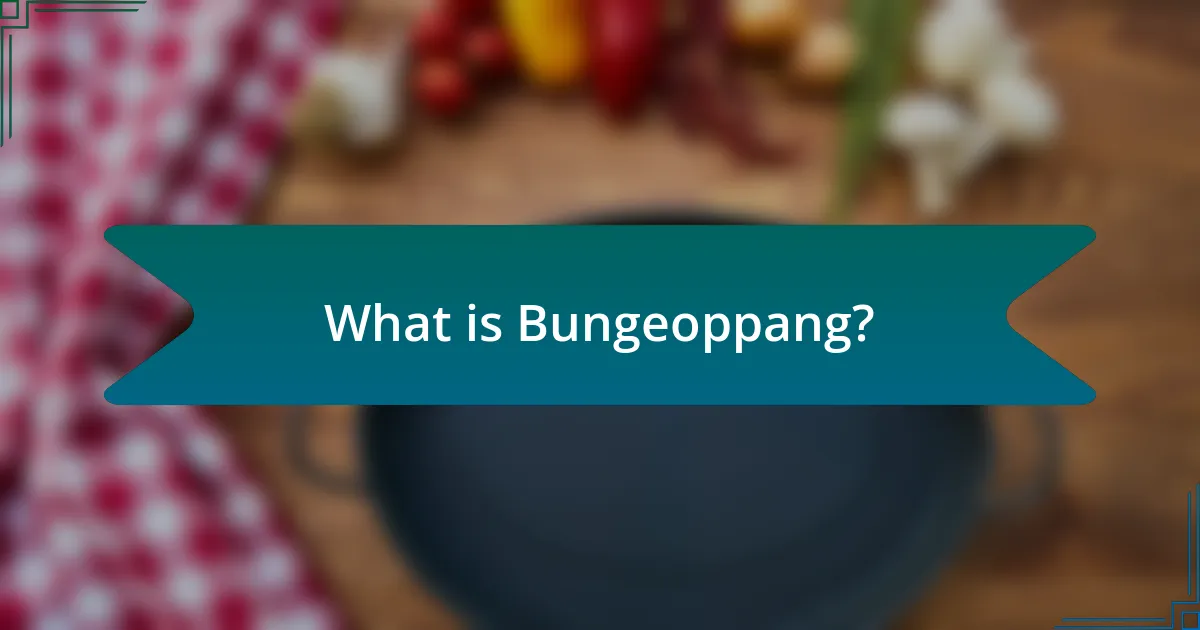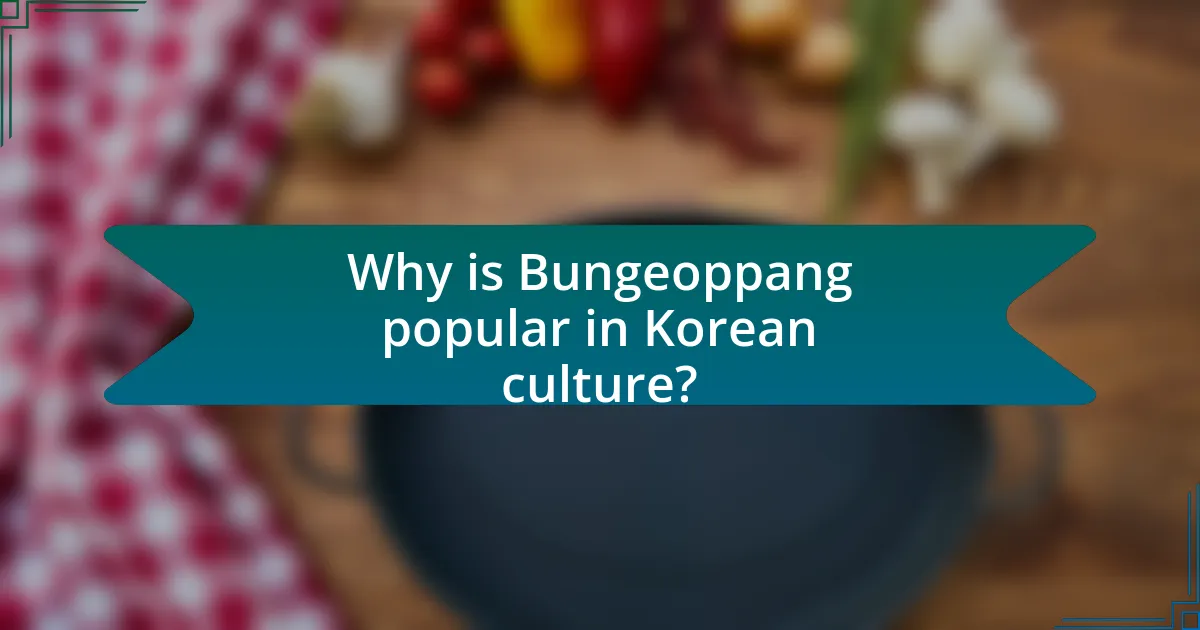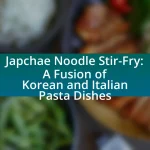Bungeoppang is a traditional Korean street food characterized by its fish-shaped pastry filled primarily with sweet red bean paste. This article explores the origins, preparation methods, essential ingredients, and variations of Bungeoppang, highlighting its cultural significance in Korean society, especially during winter months. It also discusses the health considerations associated with consuming this pastry, including nutritional content variations based on fillings and dietary restrictions. Additionally, practical tips for making, storing, and reheating Bungeoppang at home are provided, emphasizing its role as a beloved comfort food in Korean street food culture.

What is Bungeoppang?
Bungeoppang is a popular Korean street food that consists of a fish-shaped pastry filled typically with sweet red bean paste. This treat is made using a batter that is poured into a fish-shaped mold, cooked until golden brown, and then filled with the sweet filling. Bungeoppang has its origins in Korea and has become a beloved snack, especially during the winter months, often enjoyed for its warm and comforting qualities.
How is Bungeoppang traditionally made?
Bungeoppang is traditionally made by preparing a batter from flour, water, and sugar, which is then poured into fish-shaped molds. The molds are heated, and a filling, typically sweet red bean paste, is added before sealing the molds and cooking until golden brown. This method has been a popular street food in South Korea since the 1980s, showcasing its cultural significance and widespread appeal.
What ingredients are essential for making Bungeoppang?
The essential ingredients for making Bungeoppang are flour, sugar, baking powder, water, and a filling, typically sweetened red bean paste. Flour serves as the base for the batter, while sugar adds sweetness. Baking powder acts as a leavening agent, and water is necessary to achieve the right consistency. The filling, often red bean paste, provides the signature flavor of this fish-shaped pastry.
What equipment is needed for preparing Bungeoppang?
To prepare Bungeoppang, a specialized fish-shaped mold is essential. This mold is typically made of cast iron or non-stick material and is designed to create the distinctive shape of the pastry. Additionally, a mixing bowl is required for combining the batter ingredients, and a whisk or mixer is needed to ensure a smooth consistency. A ladle is also necessary for pouring the batter into the mold, while a spatula helps in flipping the pastries during cooking. These tools are crucial for achieving the authentic texture and shape of Bungeoppang.
What are the different variations of Bungeoppang?
Bungeoppang has several variations, primarily differing in their fillings and preparation methods. Common fillings include sweet red bean paste, custard, chocolate, and sweet potato, while savory options may feature ingredients like cheese or tuna. These variations cater to diverse tastes and preferences, reflecting regional adaptations and innovations in the traditional recipe.
How do sweet and savory versions of Bungeoppang differ?
Sweet and savory versions of Bungeoppang differ primarily in their fillings and flavor profiles. The sweet version typically contains fillings such as red bean paste, custard, or chocolate, offering a dessert-like taste, while the savory version often includes fillings like cheese, seafood, or vegetables, providing a more umami flavor. This distinction in fillings leads to different culinary experiences, with sweet Bungeoppang being enjoyed as a snack or dessert and savory Bungeoppang serving as a meal or appetizer.
What unique fillings can be found in Bungeoppang?
Bungeoppang typically features unique fillings such as sweet red bean paste, custard, and chocolate. These fillings are traditional and popular, with sweet red bean paste being the most common, derived from adzuki beans, which are cooked and sweetened. Custard filling offers a creamy texture, while chocolate provides a modern twist, appealing to diverse tastes.

Why is Bungeoppang popular in Korean culture?
Bungeoppang is popular in Korean culture primarily due to its nostalgic value and widespread availability as a street food. This fish-shaped pastry, typically filled with sweet red bean paste, evokes childhood memories for many Koreans, often associated with winter street food markets. Its popularity is further reinforced by its unique shape and the comforting warmth it provides, making it a favored snack during colder months. Additionally, the cultural significance of sharing food experiences contributes to its enduring appeal in social settings.
What role does Bungeoppang play in Korean street food culture?
Bungeoppang serves as a quintessential element of Korean street food culture, symbolizing comfort and nostalgia for many Koreans. This fish-shaped pastry, typically filled with sweet red bean paste, is commonly sold by street vendors, especially during the colder months, making it a popular snack choice. Its widespread availability and affordability contribute to its status as a beloved treat, often evoking memories of childhood for those who grew up enjoying it. The cultural significance of Bungeoppang is further highlighted by its presence in various media and social gatherings, reinforcing its role as a staple in the vibrant landscape of Korean street food.
How has Bungeoppang evolved over the years in Korea?
Bungeoppang has evolved from a traditional Korean street food into a popular snack with diverse fillings and variations. Initially introduced in the 1930s, Bungeoppang was primarily filled with sweet red bean paste, reflecting the tastes of that era. Over the years, the pastry has seen innovations, including fillings such as custard, chocolate, and even savory options like cheese, catering to modern preferences. The rise of food trucks and social media has further popularized Bungeoppang, leading to creative adaptations and increased visibility among younger generations. This evolution highlights the adaptability of Bungeoppang within Korea’s culinary landscape, maintaining its cultural significance while embracing contemporary trends.
What cultural significance does Bungeoppang hold during festivals?
Bungeoppang holds significant cultural value during festivals as it symbolizes warmth and comfort, often enjoyed in cold weather. This fish-shaped pastry, filled with sweet red bean paste, is commonly sold by street vendors during winter festivals in South Korea, reflecting the communal spirit and nostalgia associated with seasonal celebrations. The act of sharing Bungeoppang among friends and family enhances social bonds, making it a staple treat that evokes memories of childhood and festive gatherings.
How is Bungeoppang enjoyed by people today?
Bungeoppang is enjoyed by people today primarily as a popular street food snack, often consumed during colder months. This fish-shaped pastry, typically filled with sweet red bean paste, is commonly sold by street vendors in urban areas, especially in South Korea. Many people appreciate Bungeoppang for its warm, crispy exterior and soft, sweet filling, making it a comforting treat. Additionally, variations with different fillings, such as custard or chocolate, have emerged, catering to diverse tastes and preferences. The cultural significance of Bungeoppang is also evident during festivals and seasonal events, where it is frequently featured, reinforcing its status as a beloved comfort food.
What are common occasions for eating Bungeoppang?
Bungeoppang is commonly eaten during winter months and at street food markets in South Korea. This fish-shaped pastry is particularly popular as a warm snack during cold weather, often enjoyed while strolling through festive markets or during outdoor events. The association with winter is reinforced by its frequent appearance at seasonal festivals and holiday celebrations, where vendors sell it hot and fresh to provide comfort and warmth.
How do people typically serve and consume Bungeoppang?
People typically serve Bungeoppang hot and fresh, often directly from street vendors or food stalls. This fish-shaped pastry is usually filled with sweet red bean paste, custard, or other fillings, and is enjoyed as a snack or dessert. Consumers often eat Bungeoppang by holding it in their hands, taking bites from the crispy outer shell while savoring the warm filling inside. The popularity of Bungeoppang is evident in its widespread availability during winter months in South Korea, where it is commonly associated with street food culture.

What are the health considerations when consuming Bungeoppang?
Bungeoppang, a popular Korean pastry, poses several health considerations primarily due to its ingredients and preparation methods. The pastry is typically made from refined flour, sugar, and sweet fillings like red bean paste, which can contribute to high carbohydrate and sugar intake. Consuming Bungeoppang in moderation is advisable, especially for individuals managing blood sugar levels or those with diabetes, as the high glycemic index can lead to spikes in blood glucose. Additionally, the frying process can increase the calorie content and introduce unhealthy fats, which may impact heart health if consumed excessively. Therefore, while Bungeoppang can be enjoyed as an occasional treat, awareness of its nutritional profile is essential for maintaining a balanced diet.
How does the nutritional content of Bungeoppang vary by filling?
The nutritional content of Bungeoppang varies significantly based on the filling used. For instance, a red bean filling typically contains higher fiber and protein content, while a custard filling may have more sugar and fat, leading to a higher calorie count. Additionally, fillings like sweet potato or chocolate can alter the carbohydrate and fat levels, affecting overall nutritional value. Each filling contributes distinct macronutrients and micronutrients, influencing the health benefits and caloric intake of the pastry.
What are the calorie counts for different types of Bungeoppang?
Bungeoppang, a popular Korean fish-shaped pastry, has varying calorie counts depending on its filling. A plain Bungeoppang typically contains around 200 calories, while those filled with sweet red bean paste can have approximately 250 calories. Variants filled with custard or cream may range from 300 to 350 calories. These calorie counts are based on standard serving sizes and can vary slightly based on preparation methods and specific ingredients used.
Are there any dietary restrictions to consider with Bungeoppang?
Bungeoppang typically contains wheat flour, sugar, and fillings such as red bean paste or custard, which may pose dietary restrictions for individuals with gluten intolerance or celiac disease. Additionally, those with allergies to wheat, eggs, or dairy should exercise caution, as these ingredients are commonly used in the preparation of Bungeoppang.
What tips can enhance the Bungeoppang experience?
To enhance the Bungeoppang experience, consumers should focus on enjoying the pastry while it is freshly made and hot. Freshly cooked Bungeoppang has a crispy exterior and a warm, gooey filling, which significantly elevates the taste and texture. Additionally, pairing Bungeoppang with a hot beverage, such as tea or coffee, complements its sweetness and provides a comforting experience. The ideal filling, typically sweet red bean paste, can also be enhanced by trying variations like custard or chocolate, which cater to diverse taste preferences. These tips are supported by the popularity of Bungeoppang in street food culture, where freshness and pairing with drinks are commonly emphasized for an optimal tasting experience.
How can one make Bungeoppang at home successfully?
To make Bungeoppang at home successfully, one must prepare a batter using flour, sugar, baking powder, and water, then fill fish-shaped molds with the batter and a sweet filling, typically red bean paste. The process begins by mixing the dry ingredients and gradually adding water to achieve a smooth consistency. After preheating the molds, pour a small amount of batter into each mold, add the filling, and cover with more batter. Cook until golden brown, which usually takes about 3-5 minutes per side. This method is validated by traditional recipes that emphasize the importance of even cooking and the right batter consistency for optimal texture and flavor.
What are the best practices for storing and reheating Bungeoppang?
The best practices for storing Bungeoppang involve placing them in an airtight container at room temperature for up to one day or refrigerating them for up to three days. For reheating, the optimal method is to use an oven or toaster oven at 350°F (175°C) for about 5-10 minutes to restore their crispiness. This method is effective because it allows the pastry to regain its texture while evenly warming the filling.


